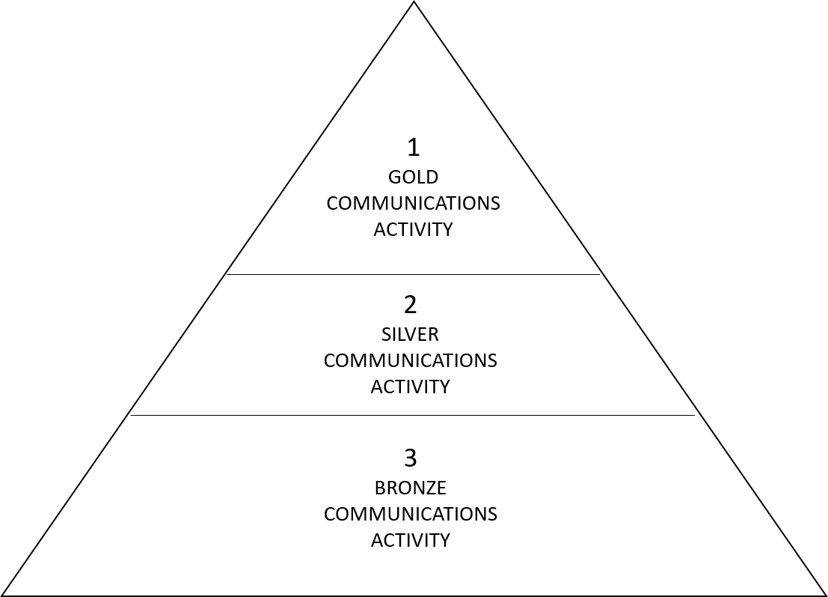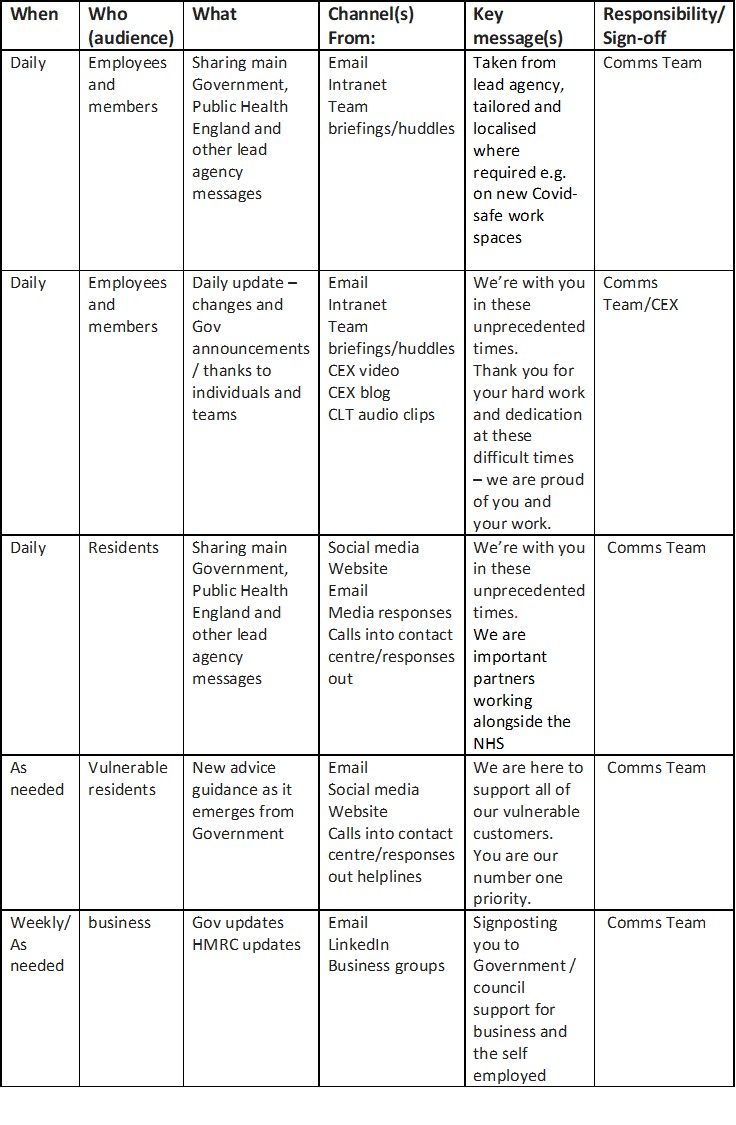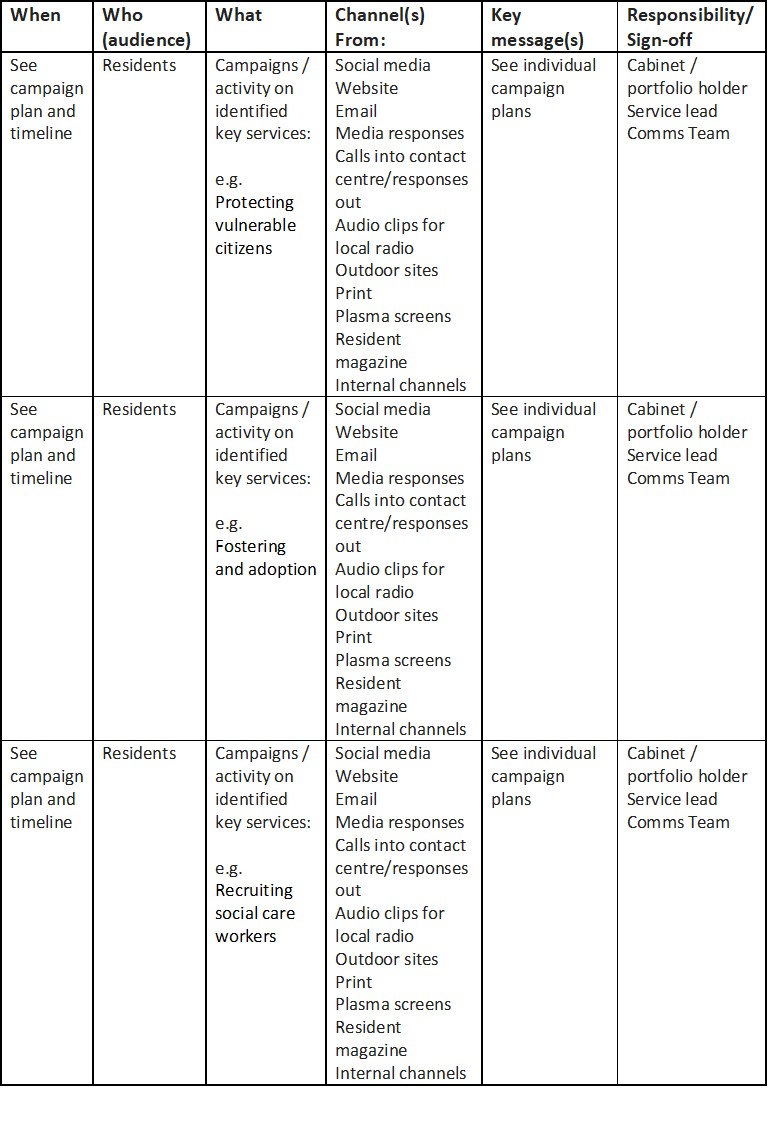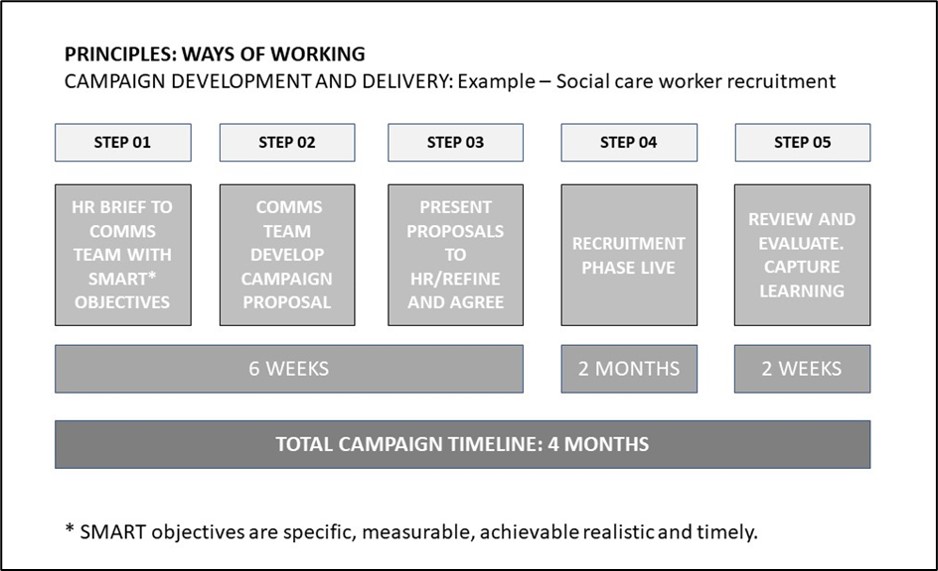As we move towards recovery and planning for this next phase, it is important that councils prioritise their communications activity. Effective prioritisation should be used to plan for all communications activity, done by both the corporate communications team and any other teams.
At its heart of this prioritisation approach is the single aim of safeguarding and protecting the health and wellbeing of our residents and businesses, staff and members. It does this through identifying key activities and is an outcome-focused, key campaign-led approach.
A prioritisation approach should be agreed on and signed off by the chief executive and leader of the council.
Principles
This approach provides clear and simple direction and prioritisation for the most important communications work to be developed and delivered during the crisis.
Previously agreed communications campaigns, projects and priorities are mostly on hold at this time. It isn’t possible for everything to be delivered effectively, so activity and all demand requests will be given a gold, silver and bronze status for the duration of the crisis and recovery.
This will allow the council and the communications team to deliver the most important work well.
Where other agencies and partners are the lead you should support their work, share their messages, use their content and not re-invent the wheel.
Where the council is the lead agency you should ensure that you have listened to residents, and that businesses and relevant partners are kept up to date.
We recommend adopting a ‘staff and members-first’ approach whereby all key activity and messages are first shared internally, and then with external stakeholders. This approach should also apply to the work of all other services so that as an organisation you are briefed and updated internally first.
There is a huge amount of information currently being shared nationally and locally and there is a danger that our residents are being bombarded with information. Councils should make their communications count – by keeping them simple, targeted, human, respectful and two-way where possible.
The communications team should review the council’s overarching strategy regularly and report back on its delivery to the corporate leadership team and Cabinet monthly.
Prioritising our work – delivery model
Previously agreed campaigns, projects and priorities are now on hold. It isn’t possible for everything to be delivered and delivered effectively so activity and all demand requests will be given a gold, silver and bronze status for the duration of the crisis and as we progress into the various stages of recovery.
To ensure the best possible communications and engagement outcomes we have adopted the following delivery model:
Almost all of our communications time and resources will be focused on gold and silver activity during the crisis and recovery stages.
What does this mean in practice?
Gold activity
Is aimed at the protection, health and wellbeing of all residents during the COVID-19 crisis. This will include the sharing of national messaging from the lead agencies of Public Health England, NHS England, the Government and its departments, and the Local Government Association. A great deal of content, resources, channels and websites already exist in this space so we will simply make use of these and not re-create our own content when we don’t need to. Where relevant and helpful we will put a local stamp on this activity if it’s helpful to do so.
Silver activity
Gives priority to the most important council services – for example: protecting vulnerable citizens, social care, adult social care, free school dinners, support services for partners and charities supporting the homeless, benefits, support to our businesses, our schools who are supporting the children of essential workers and in their planning for schooling in the medium and long term, trading standards around COVID-19 related scams, and our parks and green spaces which are being well used at this time.
The communications team will still need time and space to create engaging content and helpful advice, considering the most appropriate channels – digital and non-digital – to share these messages. Wherever possible the team should ensure that these communications are two-way so that residents can engage and ask questions/receive answers.
It is important that the council continue to ensure that all of COVID-19 support and information is simple but effectively presented and always in easy-to-find places e.g. on one clear section of the website, in one email, in one Twitter Thread and Facebook post or advert.
Bronze activity
All other communications activity and demand received into the communications team. This work is not a priority during the crisis and recovery stages and is not likely to be delivered by the communications team unless the pressure eases and they find themselves with the resources to do it.
Instead the team should provide templates and guidelines for services to self-service their own communications activity*.
*It’s important that any communications activity delivered by services themselves fulfils the standards expected by the council and does not cause reputational risk, doesn’t cover contentious or controversial topics, and is avoided if it does not add genuine value to residents and businesses at this difficult time. A simple risk assessment should be applied by the services to decide whether they should deliver this bronze activity or not.
In terms of attention spans and newsworthiness COVID-19 is very much the main story right now and activity not supporting this local and national effort is likely to have minimal impact. Please consider this before requesting or delivering your own communications activity.
Example: Gold activity
Example: Silver activity
Bronze activity
This activity is not guaranteed to be delivered by the communications team as it is not agreed in the revised annual communications strategy for the council 2020/21 signed off by cabinet and the corporate leadership team.
Services should ask themselves if their potential communications demand requests are business critical during this time of national crisis.
If so, and the communications team does not have the resource to deliver this bronze activity, services will deliver it themselves. This will be done via templates provided by the communications team and must follow all council guidelines on corporate identity, tone of voice, social media use, the pre-election period and other related policies.
What are they, how long to they take to deliver, and how should we use them?
Campaigns take time to do well. A lot of time.
They should always be insight-led and be focused on the most important work of the council. Not all of the council’s work could and should be the focus of a communications campaign.
Spread campaigns too thin and they become watered-down and as a result less effective.
They eat up resource too – time for sure but also sometimes budget.
Councils should not be trying to deliver dozens of campaigns per year. It isn’t practical.
Instead Cabinets and leadership teams should be agreeing the most important council priorities and agreeing and supporting the campaigns which will underpin them. Five or six key campaigns per year is a sensible target for most councils.
Of course, it depends upon available resource, which will differ form council to council, and of course priorities can change as new challenges emerge. But COVID-19 has really focused our minds and prompted a rethink on which services and initiatives are important. In turn, this means councils need to strip back and do less of the communications activity which doesn’t add value to our residents and businesses.
Less can be more and that should be a guiding principle for the work of the communications team if recovery is to be a realistic deliverable for the team.
How long do campaigns take to deliver?
It’s a good question and can vary greatly. A campaign can take just a day to run – think of the LGA’s ‘annual ‘Our Day’ initiative on social media and online. But a huge amount of prep, planning and content creation goes into the campaign ahead of the day, as well as evaluation, learning and reporting back afterwards.
Other campaigns in effect could constantly run. Fostering and adoption is a good example, where, for many councils, it’s a continual challenge and priority every year.
Communications teams need to be given time and space to think, research, plan and create their strategic campaigns. They can’t be turned around in 10 minutes.
So it’s important that councils build this into their planning processes and internal timelines.
Here’s an example timeline for the creation of a campaign – this one is for a recruitment campaign to attract social care workers to a council




